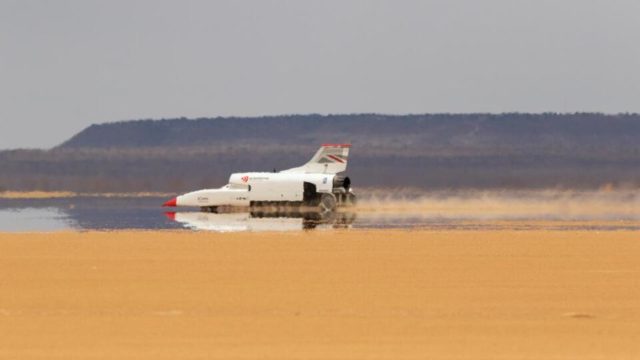This was the sixth salt pan run for the supersonic car, which is being pushed faster with each outing by driver Andy Green.
HAKSKEEN PAN, NORTHERN CAPE – The Bloodhound Land Speed Record car achieved its highest speed ever on Tuesday, closing in on its 500mph / 804km/h testing target speed with a 790km/h run – which you can see for yourself in the video below.
This was the sixth salt pan run for the supersonic car, which is being pushed faster with each outing by driver Andy Green, who holds the current World Land Speed record of 1228km/h.
While that kind of speed won’t be achieved during the current testing phase, the team is gathering vital data from each run with the aim of eventually toppling the current record, and perhaps even breaking the 1600km/h barrier. The new record attempt is likely to take place later in 2020.
“The aim of today was to measure the slowdown, from 500 down to 200, to measure the aerodynamic drag,” Green said after Tuesday’s run. “We’ve got all that data, and now it’s time to crunch the numbers.”
According to the team, the car remained directionally stable throughout the run, however the centre screen failed at the 627km/h mark, which increased the cockpit workload significantly.
It hasn’t been all plain sailing for the Bloodhound LSR team since their arrival at Hakskeen in mid-October. First there was trouble getting the Typhoon EJ200 jet engine fired up due to faulty fuel sensor calibration. After fixing this, the anti-corrosion fluid was burnt off, but the start-up cycle took four seconds longer than the permitted one minute start process allowed by ECU for safety reasons.
After all the teething troubles had been resolved, the car made its first official run, hitting 160km/h in an attempt to check if the steering and brakes were in working order. The second outing doubled that speed using max dry power (power without extra fuel for reheat), followed by a coast down to measure rolling resistance. The next run saw the team using full reheat to hit 537km/h, with stability tests conducted before and after the peak speed was reached.








